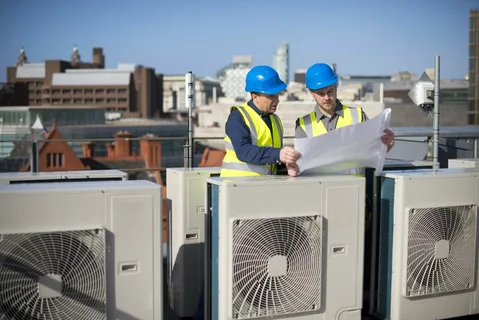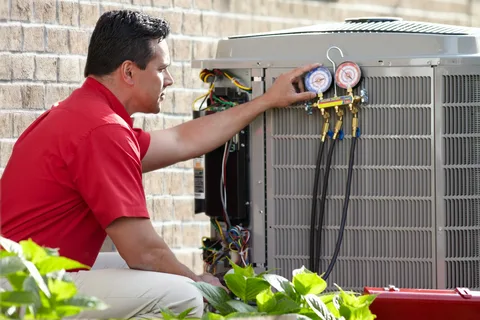When it comes to creating a comfortable, healthy and energy-efficient living or working environment, understanding the basics of heating and ventilation is essential. This knowledge allows us to control the indoor climate effectively, ensuring optimal comfort levels throughout the year.
An Overview of Heating & Ventilation
Heating & ventilation form the backbone of comfortable indoor environments, ensuring optimal temperature control and air quality. Heating systems, such as furnaces, boilers, or electric heaters, elevate ambient temperatures during colder months. Ventilation, on the other hand, involves the exchange of indoor and outdoor air to maintain freshness and remove pollutants. Efficient heating systems distribute warmth evenly, considering factors like insulation and room size.
Modern advancements, including smart thermostats and energy-efficient technologies, enhance control and reduce energy consumption. Ventilation systems, whether natural or mechanical, are crucial for air circulation. Natural ventilation utilizes windows and vents, while mechanical systems employ fans and ducts to regulate airflow. Proper ventilation minimizes indoor pollutants, controls humidity, and contributes to a healthier indoor environment.
The Role of Heating and Ventilation Companies
Heating & ventilation companies play a pivotal role in ensuring comfort, energy efficiency, and air quality in various settings. Heating & ventilation companies specialize in designing, installing, and maintaining systems that regulate indoor temperatures and air circulation. Heating & ventilation companies are essential in residential settings. They provide homeowners with efficient heating solutions during colder months and ensure proper ventilation, promoting a healthy indoor environment.
These companies offer a range of heating systems, such as furnaces and heat pumps, tailored to meet specific needs. In commercial and industrial sectors, heating and ventilation companies are indispensable for creating optimal working conditions. They design HVAC systems that cater to large spaces, addressing both heating and cooling requirements. Regular maintenance services offered by these companies ensure the continued efficiency and longevity of these complex systems.
Moreover, heating & ventilation companies contribute significantly to energy conservation. By incorporating advanced technologies and energy-efficient components, these companies help clients reduce their carbon footprint and operational costs. The expertise of heating & ventilation companies is instrumental in navigating the evolving landscape of sustainable and eco-friendly heating and cooling solutions.
The Importance of Proper Ventilation
Ventilation goes beyond just temperature control; it plays a vital role in maintaining a healthy and comfortable indoor atmosphere. By effectively managing the air exchange within a given space, it helps to eradicate airborne contaminants, such as dust and allergens, thus reducing potential health risks. The process of ventilation is also critical in mitigating the buildup of moisture, a key culprit for mould growth that can lead to structural damage and health issues.
By maintaining optimal humidity levels, proper ventilation can contribute significantly to the longevity of your property. Furthermore, the role of ventilation in maintaining an ideal indoor temperature shouldn’t be overlooked. A well-ventilated space provides a comfortable environment that can enhance the occupants’ productivity and overall well-being. Therefore, understanding and implementing proper ventilation strategies can significantly impact our indoor living and working conditions.
From improving air quality to preventing structural damage, the benefits of adequate ventilation are numerous and far-reaching. Whether you’re planning a new building project or upgrading an existing one, giving due consideration to ventilation is a step in the right direction towards achieving a healthier and more comfortable indoor environment.
Understanding the Heating and Ventilation Unit
A heating & ventilation unit, often referred to as an HVAC system, is a complex assembly of components that work in harmony to regulate the indoor environment by managing temperature and air circulation. This intricate system is comprised of various parts, each serving a specific function. The heater’s primary function is to increase the air temperature during cooler periods.
Simultaneously, the fan is responsible for distributing this warmed air throughout the building, creating a uniform temperature. The distribution process is facilitated by a network of ducts that serve as conduits for the flow of air. Control mechanisms oversee the system’s operation, adjusting the temperature and airflow based on the desired settings.
As with any complex system, each component of the heating and ventilation unit plays a crucial role. Understanding how they interact can aid in diagnosing problems and optimizing performance. This knowledge also underscores the importance of regular maintenance and professional installation to ensure the system operates at peak efficiency, providing a comfortable and healthy indoor climate year-round.
Benefits of Proper Ventilation
Proper ventilation is integral to a healthy and comfortable indoor environment, offering numerous benefits for both occupants and the building structure. Effective ventilation enhances indoor air quality by ensuring a continuous exchange of fresh air, reducing the concentration of pollutants and allergens. This leads to a healthier living or working space, minimizing respiratory issues and promoting overall well-being. Proper ventilation contributes to temperature regulation.
By expelling excess heat and moisture, ventilation helps maintain a comfortable atmosphere. This is particularly crucial in preventing the growth of mould and mildew, safeguarding not only the building’s structural integrity but also the health of its occupants. Efficient ventilation plays a significant role in energy conservation. By managing indoor temperature and humidity levels, it reduces the workload on heating and cooling systems, leading to lower energy consumption and cost savings.
Furthermore, proper ventilation aids in preventing the buildup of unpleasant odours, ensuring a more pleasant and inviting environment. Moreover, good ventilation promotes productivity and concentration. In workplaces and educational settings, a well-ventilated space fosters better cognitive function, alertness, and overall performance. Adequate ventilation is essential for compliance with building codes and regulations, ensuring the safety and well-being of everyone within the premises.
Tips for Ventilation Installation
Proper ventilation-installation is essential for maintaining a healthy and comfortable indoor environment. To optimize ventilation-installation, consider the following tips. Conduct a thorough assessment of your space to determine the most effective placement for ventilation-installation. Strategic placement ensures optimal air circulation and distribution throughout the area. Choose appropriate ventilation systems based on the specific needs of each space.
Tailoring ventilation installation to the room’s size, purpose, and occupancy helps maximize efficiency. Ensure that the chosen ventilation-installation aligns with local building codes and regulations to guarantee safety and compliance. Regular maintenance is crucial for the longevity and effectiveness of ventilation-installation. Clean filters and ducts, inspect components and address any issues promptly. Investing in energy-efficient ventilation-installation can lead to long-term cost savings and reduced environmental impact.
Consult with professionals for ventilation-installation projects. Experienced technicians can provide expert advice, ensuring that the selected ventilation systems meet the unique requirements of your space. By prioritizing strategic placement, system selection, regular maintenance, and professional guidance, ventilation-installation can significantly contribute to a healthier and more comfortable living or working environment.
Maximizing Ventilation Efficiency
Maximizing ventilation efficiency is crucial for creating a healthy and comfortable indoor environment. Ventilation serves as a key component of the overall heating & ventilation system, ensuring the constant exchange of indoor and outdoor air. To enhance ventilation efficiency, consider the following strategies. Utilize natural ventilation methods whenever possible. Opening windows and doors allows fresh outdoor air to circulate through the space, reducing reliance on mechanical ventilation systems. This not only improves indoor air quality but also decreases energy consumption.
Regular maintenance of ventilation systems is paramount. Clean or replace air filters regularly to prevent the buildup of dust and pollutants, which can hinder airflow and reduce efficiency. Schedule professional inspections to identify and address any issues within the ventilation system promptly. Investing in energy recovery ventilation (ERV) systems is another effective way to maximize efficiency. ERV systems exchange heat between outgoing and incoming air, reducing the load on heating & ventilation units and enhancing overall energy efficiency.
Moreover, consider incorporating smart ventilation controls. These systems use sensors to monitor air quality and adjust ventilation rates accordingly. This ensures that the ventilation system operates at the optimal level, responding dynamically to the specific needs of the indoor environment. By implementing these strategies, individuals and businesses can maximize ventilation efficiency, creating a healthier and more comfortable living or working space while also reducing energy costs and environmental impact.
Optimizing Air: The Exhaust Ventilation System
An exhaust-ventilation system functions by utilizing fans to expel stale indoor air and draw in fresh outdoor air. This operation enhances air quality by replacing potentially contaminated indoor air with fresh air from outside. Moreover, it can help regulate humidity levels, providing a significant benefit in damp climates. Exhaust vents’ positioning is a key factor in their effectiveness. Ideal locations are areas within your building that frequently produce high amounts of moisture or pollutants, such as bathrooms, kitchens, and laundry rooms.
 Strategically placed vents in these areas can efficiently eliminate moisture and pollutants, improving indoor air quality and preventing potential structural damage due to excessive humidity. Importantly, remember to maintain exhaust ventilation systems regularly to ensure their optimal operation. Check for any blockages, clean the fans, and replace any worn-out parts as necessary. Careful planning, strategic placement, and routine maintenance can maximize the efficiency of your exhaust-ventilation system, providing you with a fresher and healthier indoor environment.
Strategically placed vents in these areas can efficiently eliminate moisture and pollutants, improving indoor air quality and preventing potential structural damage due to excessive humidity. Importantly, remember to maintain exhaust ventilation systems regularly to ensure their optimal operation. Check for any blockages, clean the fans, and replace any worn-out parts as necessary. Careful planning, strategic placement, and routine maintenance can maximize the efficiency of your exhaust-ventilation system, providing you with a fresher and healthier indoor environment.
FAQ’s
How does heating & ventilation impact indoor air quality?
Heating & ventilation play a crucial role in maintaining indoor air quality. Proper ventilation ensures fresh air circulation, while efficient heating systems prevent moisture-related issues.
What are the benefits of regular maintenance for heating & ventilation systems?
Regular maintenance enhances the longevity and efficiency of heating & ventilation systems. It prevents malfunctions, reduces energy consumption, and ensures a healthier indoor environment.
How can one optimize energy efficiency in heating & ventilation?
Optimizing energy efficiency in heating & ventilation involves using programmable thermostats, sealing air leaks, and regular HVAC system maintenance. These practices reduce energy consumption and utility costs.
What role do air filters play in heating and ventilation systems?
Air filters are integral to heating and ventilation systems. They trap dust, allergens, and pollutants, preventing them from circulating in the indoor air. Regular replacement ensures optimal system performance.
How can heating & ventilation systems be upgraded for better performance?
Upgrading heating & ventilation systems may involve installing smart thermostats, energy-efficient equipment, and advanced air purification systems. These enhancements contribute to improved comfort and indoor air quality.
What are common signs of heating & ventilation problems?
Common signs of heating & ventilation issues include uneven heating, unusual odours, increased energy bills, and excessive noise. A prompt professional assessment is essential to address these issues and ensure system functionality.
Conclusion
In sum, understanding the fundamentals of heating & ventilation is crucial for maintaining a comfortable and healthy indoor climate. The role of heating & ventilation companies in the design, installation, and maintenance of these systems is indispensable. Proper ventilation ensures a healthy indoor environment and can also contribute to energy savings. Whether you are constructing a new building or improving an existing one, investing in the right heating & ventilation systems, following best installation practices, and regular maintenance are key. Here’s to creating an energy-efficient, comfortable, and healthy indoor environment.
| Other Good Articles to Read |
| Skank Blogs |
| Unreal Blogs |
| Tba Blogs |
| All City Forums |
| Dany Blogs |
| Refuge Blogs |
| The Music Blogs |
| Key Forums |
| The Big Blog Theory |
| Joe Blogs |
| Blogs 4 Me |
| Blogs Emon |
| Related Business Listings |
| Contact Directory |
| Local Business Profiles |



